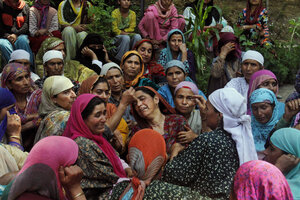Protests erupt after Indian Army kills two in Kashmir
Local residents said protests turned violent after the army refused to return one of the bodies to the villagers.

Relatives cry during the funeral procession of a shooting victim Irfan Nabi Gana at Markondal, 19 miles north of Srinagar, India, Sunday. Indian soldiers shot and killed two people and wounded another Sunday in India's portion of Kashmir, leading to violent protests that left five government soldiers injured, police and witnesses said.
Mukhtar Khan/AP
Srinagar, Indian-administered Kashmir
Indian soldiers shot and killed two people and wounded another Sunday in India's portion of Kashmir, leading to violent protests that left five government troops injured, police and witnesses said.
Police official Abdul Gani Mir said army soldiers surrounded a few houses in the village of Markondal before dawn after seeing suspicious movement and fired, killing a teenage boy. He did not elaborate on what type of movement had been seen.
As angry, stone-throwing protesters surrounded a stalled army vehicle, the soldiers fired again, killing one man and wounding another, Mir said.
Local residents said the protests turned violent only after the army refused to return one of the bodies to the villagers.
"After the second killing, protesters started throwing stones at soldiers and police," Iqbal Ahmed said.
As angry villagers tried to carry one body to the nearby town of Sumbal, they were stopped by government troops, leading to angry clashes in which at least five troops were injured, according to a local police official who requested anonymity because he was not authorized to speak to reporters.
Hundreds of police and paramilitary troops fanned out across the affected villages.
Local police are investigating the deaths. The army also said it would investigate the incident.
Rights groups say such investigations rarely lead to prosecutions and are mainly used to calm public anger.
The area is about 30 kilometers (19 miles) north of Srinagar, the region's main city.
Anti-India feelings run deep in Indian Kashmir, where nearly a dozen rebel groups have been fighting against Indian rule since 1989. About 68,000 people have been killed in the conflict.
Although the rebel groups have largely been suppressed by Indian troops in recent years, public resentment against Indian rule remains deep and the resistance is now principally expressed through street protests.


